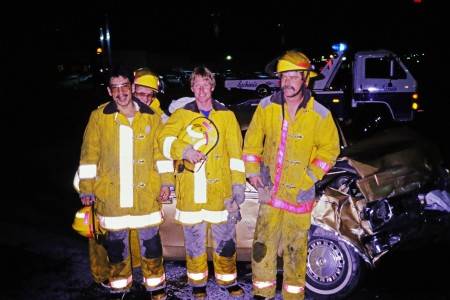CRASHING PATIENT
INTRODUCTION
Crashing patients are those adults who are medically unstable and trending in the wrong direction. They are at risk for significant deterioration while in the care of EMTs. The purpose of this Guideline is to encourage EMTs to assess and correct, as feasible and as time allows, the deteriorating physiologic parameters of the patient on-scene before transport. Not all patients are eligible for this Guideline. Delayed transport is indicated if the patient’s instability can be slowed or corrected on-scene with available resources. Otherwise, immediate transport is indicated. The goal is improving findings or a positive trend prior to transport.
GUIDELINES
1. Ensure thorough BLS and appropriate ILS/ALS interventions are implemented
2. Determine if current DNR or another advanced directive available.
3. Assess the patient for symptoms and signs of instability.
a. Obstructed or non-patent airway
b. Dyspnea and shortness of breath
c. Evidence of inadequate perfusion
d. Altered mental status
4. Consider the following vital signs as general indications of instability
a. Heart rate less than 50 or greater than 150
b. Systolic blood pressure less than 90 (some older patients with pre-existing hypertension may be hypotensive at higher readings)
c. Respiratory rate less than 8 or greater than 20
d. Pulse oximetry readings of less than 90
e. End tidal CO2 readings outside the range of 35-45
f. Glascow Coma Scale less than or equal to 13
g. High fever
h. Abnormal EKG
5. Interventions to consider (not an exhaustive list)
a. Airway manipulation or use of adjuncts
b. Oxygen administration, CPAP, BVM support
c. IV fluids, vasopressor drips (Norepinephrine recommended) or Push Dose Norepinephrine or Epinephrine (See below for Push Dose instructions)
d. Atropine (if indicated) or transcutaneous pacing for profound bradycardia
e. Prepare for advanced airway interventions
6. Transport decisions including whether it should be emergent should be decided by the senior EMT on-scene.
7. Mixing Push Doses:
8. NOREPHINEPHRINE PUSH-DOSE Inject 4 mg. of Norepinephrine into 250 ml bag. Draw out 10 ml. in a syringe. Administer 0.5 ml. every minute. One advantage of this concentration is it can be transitioned to a drip as needed.
9. EPINEPHRINE PUSH-DOSE Inject 1 mg. (1 ml.) of Epinephrine 1:1,000 into a 100 ml. bag of NS and mix well. Withdraw 10 ml. giving a concentration of 1:100,000. Push 0.5 ml. every minute prn hypotension.
INTRODUCTION
Crashing patients are those adults who are medically unstable and trending in the wrong direction. They are at risk for significant deterioration while in the care of EMTs. The purpose of this Guideline is to encourage EMTs to assess and correct, as feasible and as time allows, the deteriorating physiologic parameters of the patient on-scene before transport. Not all patients are eligible for this Guideline. Delayed transport is indicated if the patient’s instability can be slowed or corrected on-scene with available resources. Otherwise, immediate transport is indicated. The goal is improving findings or a positive trend prior to transport.
GUIDELINES
1. Ensure thorough BLS and appropriate ILS/ALS interventions are implemented
2. Determine if current DNR or another advanced directive available.
3. Assess the patient for symptoms and signs of instability.
a. Obstructed or non-patent airway
b. Dyspnea and shortness of breath
c. Evidence of inadequate perfusion
d. Altered mental status
4. Consider the following vital signs as general indications of instability
a. Heart rate less than 50 or greater than 150
b. Systolic blood pressure less than 90 (some older patients with pre-existing hypertension may be hypotensive at higher readings)
c. Respiratory rate less than 8 or greater than 20
d. Pulse oximetry readings of less than 90
e. End tidal CO2 readings outside the range of 35-45
f. Glascow Coma Scale less than or equal to 13
g. High fever
h. Abnormal EKG
5. Interventions to consider (not an exhaustive list)
a. Airway manipulation or use of adjuncts
b. Oxygen administration, CPAP, BVM support
c. IV fluids, vasopressor drips (Norepinephrine recommended) or Push Dose Norepinephrine or Epinephrine (See below for Push Dose instructions)
d. Atropine (if indicated) or transcutaneous pacing for profound bradycardia
e. Prepare for advanced airway interventions
6. Transport decisions including whether it should be emergent should be decided by the senior EMT on-scene.
7. Mixing Push Doses:
8. NOREPHINEPHRINE PUSH-DOSE Inject 4 mg. of Norepinephrine into 250 ml bag. Draw out 10 ml. in a syringe. Administer 0.5 ml. every minute. One advantage of this concentration is it can be transitioned to a drip as needed.
9. EPINEPHRINE PUSH-DOSE Inject 1 mg. (1 ml.) of Epinephrine 1:1,000 into a 100 ml. bag of NS and mix well. Withdraw 10 ml. giving a concentration of 1:100,000. Push 0.5 ml. every minute prn hypotension.
